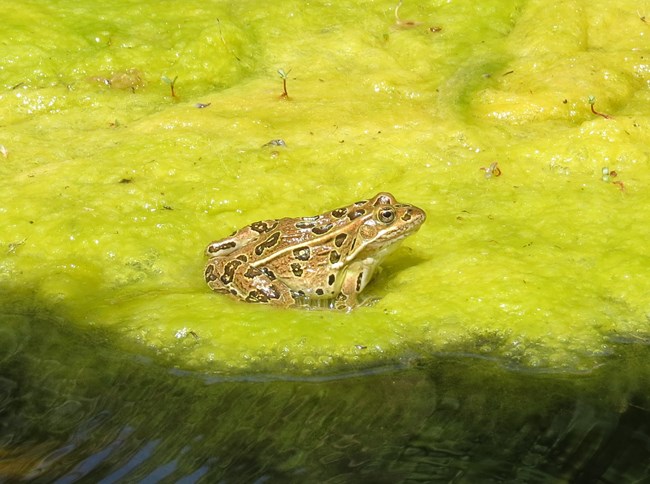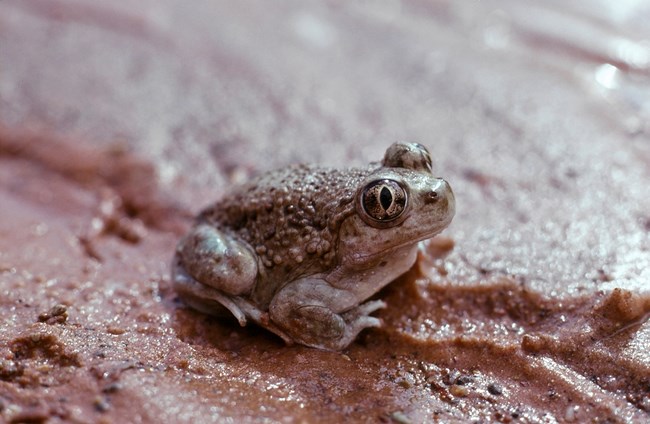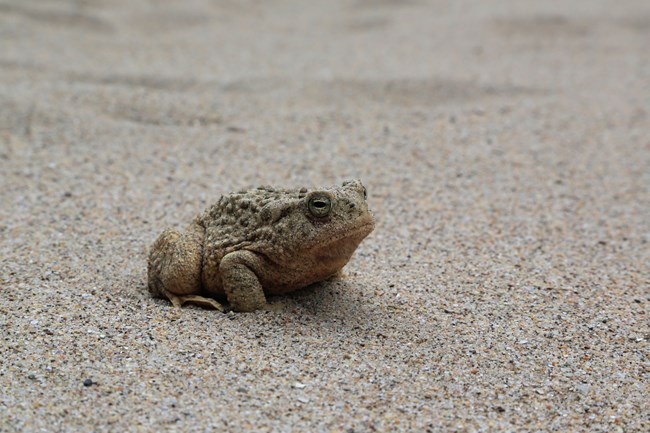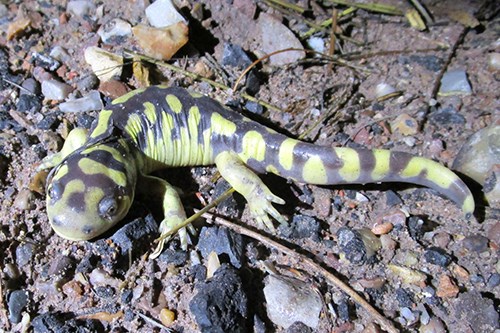
NPS / Jake Frank
Amphibians are ectothermic (cold-blooded) vertebrates that live part of their lives in water and part on land. Dinosaur National Monument is home to 5 confirmed species of amphibians. There are 4 known members from the order Anura, which includes frogs, spadefoots, and toads. The park is also home to the tiger salamander (Ambystoma tigrinum). Because of how sensitive they are to environmental change, scientists often rely on amphibian populations to gauge environmental health. In this way, amphibians serve an important role in conservation science, both here and around the world. A note on scientific names: Taxonomy is the system scientists use to classify all living organisms. Under this system, every organism has at least two names (a genus name and species name) that makes up their "scientific name." Sometimes, these names change as scientists learn more about a particular organism. Recently, many North American amphibians' scientific names have changed. While the NPS Species tool may use older names, the names listed on this webpage are correct as of February 2022. For a complete list of amphibians found in Dinosaur National Monument, use the NPS Species tool below or continue reading. Select a Park:Select a Species Category (optional):
Search results will be displayed here.
Frogs
NPS / Dan Johnson Northern Leopard Frog (Lithobates pipiens)Named for its spots, the northern leopard frog is most easily recognized by its large, dark oval-shaped patches, each haloed with a light-colored ring. The frog has smooth skin, ridges running down its back, and is usually green, brown, or yellow-green in color. Capable of growing up to 4.5 inches (11.5 cm) in length, they require links between wetland and upland habitats in order to survive. Unfortunately, leopard frogs have experienced dramatic population declines across the West. Factors that have contributed to this include climate change, habitat loss, and invasive species, such as bullfrogs and nonnative fish.Learn more about northern leopard frogs here. 
NPS / Tallgrass Prairie National Preserve American Bullfrog (Lithobates catesbeiana)While they're native to the eastern and central United States, American bullfrogs are actually an invasive species in the West. They were introduced by humans, both as a food source and to help control insect populations. Some may also have been inadvertently introduced through fish stocking practices. Unfortunately, these frogs will eat almost anything that can fit in their mouths. Besides insects, they have also been known to eat other amphibians, rodents, lizards, snakes, and even bats and birds. These behemoths can grow up to 8 inches (20 cm) in length and weigh over 2 lbs (32 oz). They both prey on and present significant competition for resources with native species, like northern leopard frogs.Spadefoots
NPS / Capitol Reef National Park Great Basin Spadefoot (Spea intermontana)These native frogs are notoriously hard to spot. Not only are they nocturnal, but they spend most of their time underground. Named for the hardened black "spades" on their feet, it's no surprise that they're great diggers. (Although, they sometimes cheat by co-opting small mammal burrows). The goal in staying below ground is to keep their skin from losing moisture to the dry air. For this reason, they prefer the loose, sandy soils near wetlands. Great Basin spadefoots have gray or olive colored bumpy skin and golden eyes with vertical pupils, giving them a toad-like appearance (However, they are not true toads). They can grow up to 2.5 inches (6 cm) long, and feed mainly on insects and worms.Toads
NPS / Dan Johnson Woodhouse Toad (Anaxyrus woodhousii)Woodhouse toads are a native species in Dinosaur National Monument. These toads have bumpy, brown, gray, or light-brown skin. They are distinguishable by a pale line running down the middle of the back. Woodhouse toads can grow up to 5 inches (12.7 cm) in length, although males are typically smaller than females. Like spadefoot toads, they spend most of the day buried underground to preserve moisture. They are common in riparian (wetland) habitats, but they can also be found in upland areas with harder soils if a permanent water source is nearby.Salamanders
NPS / Petrified Forest National Park Barred Salamander (Ambystoma mavortium)This is the only salamander found in Dinosaur National Monument, where it is a native species. Like Dinosaur's native toads, barred salamanders typically rest in burrows during the day and emerge at night. They have broad heads with protruding eyes, and average 6-8 inches (15-20 cm) in length. Their bodies are typically dark with yellow stripes, spots, or blotches. They prefer riparian (wetland) habitats and are most often seen at dusk after strong rainstorms.ConservationBecause of how sensitive they are to changes in their habitats, scientists often use amphibian populations to gauge the overall health of an environment. Unfortunately, amphibian populations around the world are in decline. They face a number of threats, including habitat loss, climate change, disease, and chemical contamination of their watery habitats. Many species of frogs and toads are also nocturnal. As such, they often have especially sensitive eyes that are adversely affected by light pollution. By trying to preserve the natural conditions of the lands they manage, National Park Service sites like Dinosaur National Monument play a big role in amphibian conservation. Read more about threats amphibians face and the National Park Service's monitoring efforts here. |
Last updated: December 18, 2024
